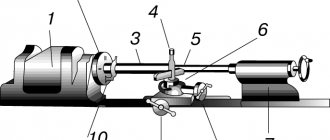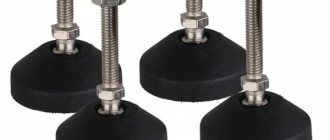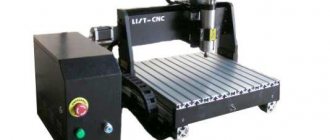In production conditions, various metalworking machines are used. They are used for the manufacture and processing of metal blanks. There are universal and specialized models. To understand metal processing equipment, you need to know the types and operating principles of metalworking machines.
Metalworking machine
Types of metalworking machines
Equipment used in the manufacturing and metalworking industries comes in many varieties. The type of machine depends on its design, control method and equipment. Based on functionality, industrial equipment can be divided into two large groups:
- Specialized - machines that perform only one specific option. Most often, they cannot be reconfigured.
- Multifunctional (universal) - combined machines. Can perform multiple production processes.
Classification of metal processing equipment by type:
- Cutting machines are machines used for cutting metal sheets and cutting workpieces. These include band saws and circular machines.
- Milling - devices with a working surface on which a cutter is fixed. Torque from the spindle is transmitted to it. As the cutter rotates, it removes a layer of metal from the workpiece. Used for machining ends, drilling holes and other operations.
Industrial machines are equipped with a CNC system. With their help, you can set a specific program according to which the key components of the machine will operate without further human intervention. However, only experienced operators can be trusted to configure the program.
A separate group includes equipment for cutting external and internal threads. You can also distinguish between home and industrial devices. The former are intended for small workshops and garages, the latter for mass production of certain parts. The remaining groups of metalworking equipment will be described below.
Machinery equipment repair
Industrial machines are operated in fairly harsh conditions, so they periodically break down and require repair. Repairing machine equipment is quite a serious matter and therefore it must be carried out by qualified specialists.
There are two main types of repairs:
- Maintenance. This is the simplest option for repair work, during which breakdowns of individual machine elements can be eliminated. Typically, routine repairs do not require a lot of time and are carried out directly at the installation site of the equipment.
- Major renovation. Such repairs can also be carried out at the installation site, but more often this requires a specialized workshop. During a major overhaul, the equipment is completely disassembled; this is necessary in order to accurately diagnose the problem. The main objective of such repair work is to restore the original capabilities of the equipment.
Another type of maintenance relates to machine modernization. This service has become widespread recently. It allows you to make the equipment more versatile and adds new functions to it.
Advanced Metalworking Techniques
Industrial equipment is constantly being improved. What features are being improved:
- Performance. This is an important factor that affects the payback of the equipment and the profit that can be obtained when working on the machine. Productivity increases as the speed of the mechanisms increases.
- Accuracy. To reduce the number of defects, equipment manufacturers are working on the accuracy of operating mechanisms.
- Durability and wear resistance.
The most common operation in which metalworking machines are used is cutting.
Gas metal cutting
Gas cutting equipment has been used for a long time. It is fully automated and requires minimal effort to operate. The CNC system makes it possible to perform even cuts on metal workpieces, which was problematic due to the presence of the human factor.
Advantages of gas cutting:
- high speed and productivity;
- cheap equipment.
Minuses:
- heat shrinkage of metal after completion of work;
- possible errors in accuracy.
Gas equipment is installed in large enterprises and private workshops.
Gas metal cutting
Plasma cutting
The principle of operation of plasma devices is that the cutting of a workpiece or sheet occurs using a plasma jet. Such metalworking machines have high cutting accuracy and productivity.
Laser processing
Laser machines for metal processing are popular in private workshops and in production. The laser head moves along guides and cuts the workpieces into marked parts. Engraving can be done with a laser beam. Such machines have high precision. They are used to process homogeneous metals and soft alloys.
Grinding
Grinding machines are designed for finishing metal surfaces. Depending on the required removal thickness, the fraction of abrasive wheels or sanding belts is selected. More than one abrasive wheel or belt can be attached to one machine.
Turning
The turning group includes designs that are used to create parts of complex shapes. The working part is a rotating spindle into which the workpiece is fixed. To process a workpiece, it is necessary to secure certain cutters in a support and bring parts to them. Sharp edges cut off the metal layer under the influence of rotation. Can be used for drilling, threading inside and outside workpieces, countersinking, boring holes.
Drilling
Drilling machines are devices with a fixed frame on which one or more spindles are fixed in a vertical position. They can be used for drilling, countersinking, and internal threading. Taps can be used to bore holes in workpieces.
Drilling machine
Waterjet and electroerosive
This is equipment used for cutting metal sheets of any thickness. The principle of operation is that the metal is cut using a thin water jet, which acts on it under high pressure. The disadvantage of this method is low speed. However, it is compensated by high cutting precision.
Gantry metal gas cutting machines
The equipment is intended for production. This is due to the ability to place large metal sheets on the working surface. Their sizes can reach 3×12 meters. The pros and cons of such machines are exactly the same as those of conventional gas cutting.
Machine for bending reinforcement (and cutting)
So-called bending machines are used mainly in construction, because very often you have to deal with reinforcement. It is used in concrete structures and many others. To pour reinforcement with concrete, it must be cut into certain pieces at a certain angle. A cutting machine is used for this.
Bending machines evenly bend the reinforcement. Without this special equipment, it is not only impossible to bend the reinforcement, much less do it evenly and evenly.
Automation levels
According to the level of automation, metalworking machines are divided into the following types:
- Manual equipment. All mechanisms are controlled by humans.
- Semi-automatic devices. In such machines, half of the mechanisms operate automatically, while the other requires adjustment and control by a master.
- Automatic machines. Equipment that can work independently. The operator should initially set the algorithm for the moving mechanisms.
- CNC machines. Fully automated designs that require a program to operate. In accordance with it, the mechanisms and working parts of the machine will move.
The most popular are machines equipped with CNC systems. Numerical control consists of several key elements:
- Console - through it the operator sets the program according to which the production process will take place. In addition to automatic operation, the console has a remote control for manual control.
- A controller is a mechanism that calculates future movements of moving mechanisms and machine elements. The controller is a powerful microprocessor that controls all mechanisms.
So that the operator can see what program he is specifying, there is a screen in the CNC system. It displays algorithms, dimensions of the workpiece being processed, possible errors and inaccuracies.
Automation of metalworking
Operation and maintenance of machine tools
Machine tools are quite complex mechanical and technical systems, the operation of which requires certain knowledge.
Manufacturers of machine tools accompany each product with special documents, which contain data that allows for proper control and operation of specific equipment.
These documents provide information about the machine, its controls, lubrication schemes and the location of certain components and assemblies. Such accompanying documents also indicate the maintenance of the machine, its repair and safety precautions.
The machine equipment operation system must operate in such a way as to minimize downtime and ensure normal operation.
For smooth operation it is necessary:
- timely supply of machines with the necessary workpieces, parts, lubricants, tools;
- carrying out operations for loading workpieces, cleaning, removing chips, filling coolant and lubricating parts;
- timely detection of breakdowns and malfunctions with their subsequent elimination;
- replacement or restoration of failed structural elements and assembly units.
Machine equipment must undergo scheduled maintenance. Since unscheduled maintenance increases the failure rate of equipment, leads to a decrease in its durability, and, accordingly, increases the costs of the enterprise.
Design
The design of metalworking machines is a connection of several key parts and mechanisms. Main operating elements of the equipment:
- Cast frame. Acts as a base. The rest of the machine parts are attached to it. Must dampen vibrations arising from engine operation.
- Control system. It is a remote control for setting up moving mechanisms.
- Spindle with chuck for equipment.
- Work surface with clamps for workpieces.
In addition to key components, guides, protective shields, calipers, movable heads and other additional elements are distinguished. We must not forget about the cooling systems. They can be air or liquid. Used on industrial equipment under heavy loads. On CNC devices, additional electric motors are installed, which are responsible for the mobility of the working part of the equipment along the guides.
There are different types of metalworking machines on sale. They differ in design, functionality, purpose, dimensions, and control systems. When choosing a production machine, these features should be taken into account. Wear-resistant designs are chosen for mass production. Less productive equipment is suitable for a garage or workshop.
Units, equipment and accessories for metal-cutting machines
- 16B20p.070
feed box for lathes Gomel - 16B20p.061
apron for lathes Gomel - AKP 109-6.3
automatic transmission - AKP 309-16
automatic transmission - EPU 2-2
electric drives EPU2-2 - UDG-100 (UDG N-100)
universal dividing head Ø 200 LOMO - UDG-135 (UDG N-135)
universal dividing head Ø 270 LOMO - UDG-160 (UDG-D-160)
universal dividing head Ø 160 LOMO - UDG-200 (UDG-D-200)
universal dividing head Ø 200 LOMO - UDG-250 (UDG-D-250)
universal dividing head Ø 250 LOMO










